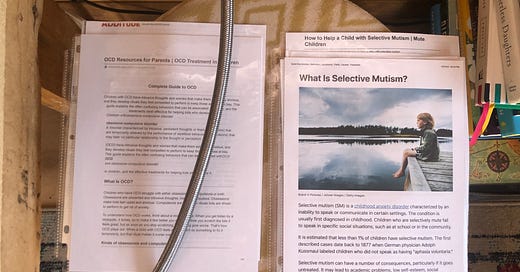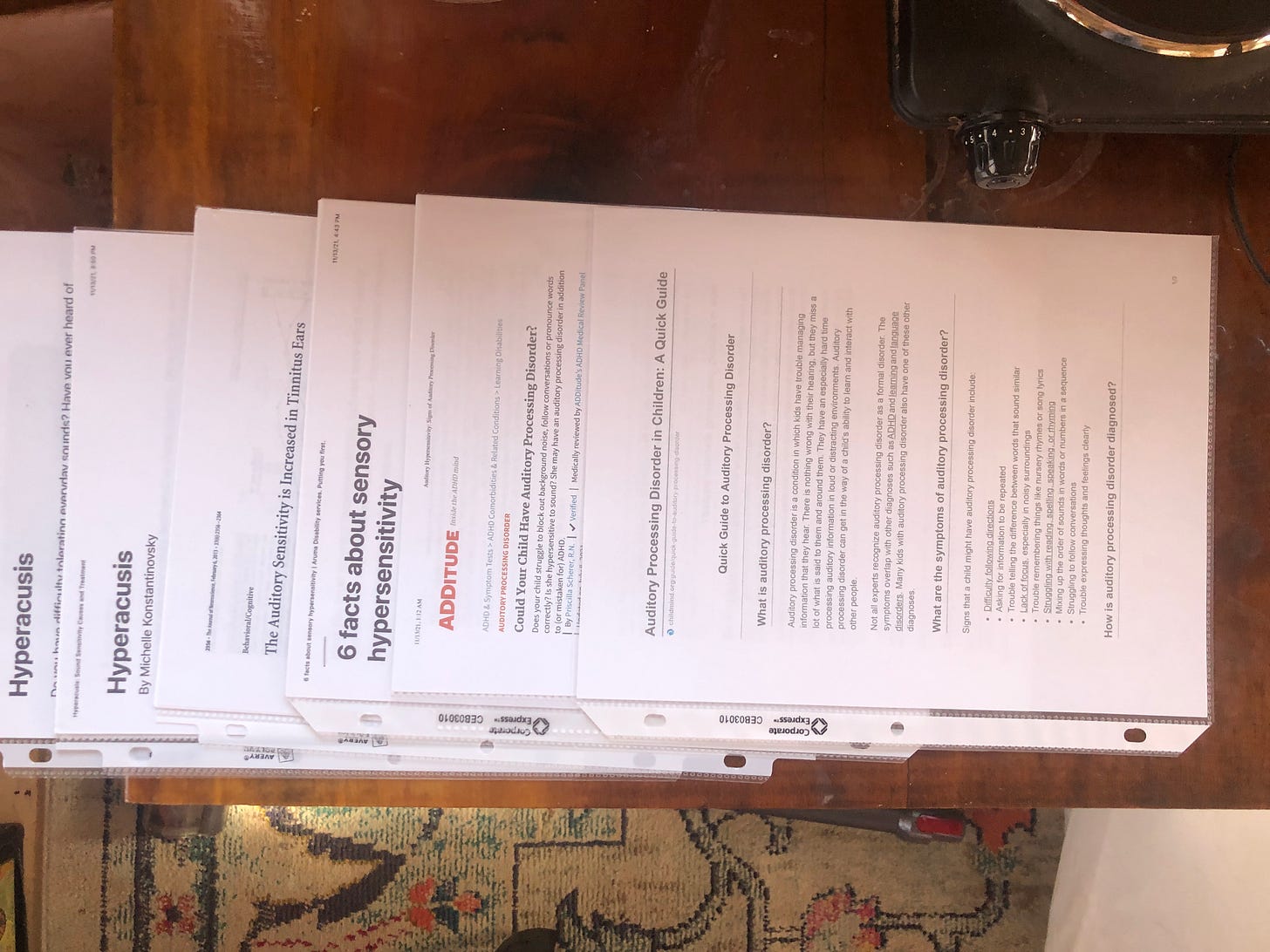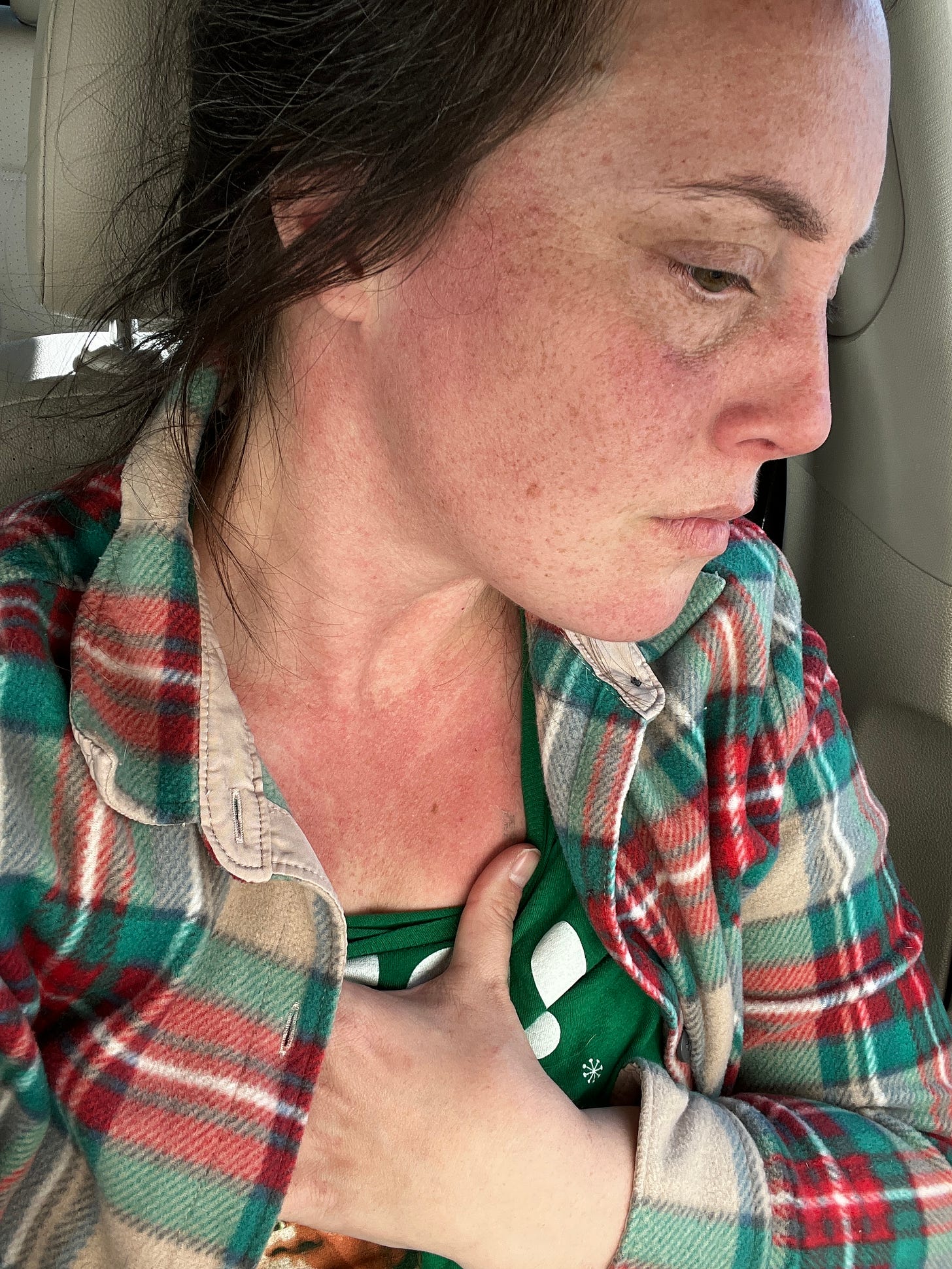It's Not Safe to Be Me Series — Part 2: Implosion
“People need to stop throwing that term [Autism] around.”
Read the Preface here and Part 1 here.
After November 16th, I was running on fumes, barely holding it together. Levi was still without access to his medication. The sensory overload and the awareness of not being myself were crushing. With no relief in sight, I had spiraled into a state of crisis.
Hypervigilance.
Desperate to make life feel manageable again, I plunged deeper into an obsessive search for answers.
This thinking drove me, “It has to be more than ADHD. I have to figure this out. Me figuring it out is the only way this will get better because no one else is figuring it out for us.”
In December, from our therapist’s recommendation, we scheduled a full psychological assessment of Levi for mid-January. Let me tell you. The instant we booked the assessment, I entered preparation mode. For me, everything was heightened.
I’m talking WEEKS of madness.
I’m pretty sure I was hypomanic and experiencing OCD.
Hypomania, even if you’re not bipolar, can be triggered by trauma, and it can look goal-oriented.
OCD is about not feeling in control. The intrusive thoughts, “I have to figure this out. I need to be prepared,” were fierce.
I couldn’t stop preparing for the assessment.
The hunger to feel prepared was insatiable. I barely slept. My thoughts were faster and more dimensional than usual. I felt amped up. Everything was riding on that upcoming assessment. At least, it felt that way.
Think about it.
Apart from this one thing, we had no other resource or help on the horizon. Every fiber of my being needed this assessment to provide answers so that we could get relief or at least direction. I was desperate.
I was so emotionally attached to the outcome of the assessment that I became completely consumed by a compulsion, which I called “preparation.”
My distress tolerance? Gone.
My soothe skills? Unavailable.
I scoured every story, photograph, and video we had and pored over psychology journals and articles for any clue, insight, or validation that could explain what was happening.
The information piled up.
I printed pages and pages of content, sorted them into stacks all over my cabin, and organized them into 3-ring binders (binders—plural!).
I put together reports using Canva and Google Docs.
It was madness.
It was… intense.
For weeks.
The assessment was over two days in Asheville, North Carolina, a little north of us. So, I turned the trip into a mom-and-son adventure for Levi and me. I booked a hotel with a pool, planned for a pizza night, and brought my computer and his X-box because INTERNET! For context: We don’t have home internet.
On the morning of the assessment, I went into the psychologist’s office, clinging to the hopeful idea that we might get some clarity and direction but also guarded. I’d read too many stories of misdiagnosis and not being believed.
And just like that, during the morning of day one, the psychologist’s words crushed my hope.
She began with, “So, why do you think he’s Autistic?”
If I’d only known then what I know now… I would’ve asked for an accommodation for open-ended questions.
Why? Because my mind went blank at such a critical moment. I stumbled through a few points that felt important but didn’t capture the full picture.
She responded, “Hmm. I don’t think that’s it. He’s too socially motivated and empathetic. He noticed you were upset and put his hand on your back.”
Inside, I was screaming. This view is outrageously dated and stereotypical. This was precisely what I read online about others experiencing during assessments.
The world faded as I was locked in on this thought, “It’s happening to us.”
A bit later, as she reiterated her disbelief that Autism was in the mix, she added, “And people need to stop throwing that term [Autism] around.”
A bomb went off inside me, but I remained in my mask, composed and unmoved. But when we got back to the hotel that afternoon, I lost it. Completely.
And with that, I ruined our mom-and-son adventure.
I managed to hold it together for the second day of the assessment, but as soon as we got in the car to drive home, I couldn’t contain it any longer. I broke down, sobbing while driving. In his innocence and big empathy, Levi reached from the back seat to rest his small hand on my arm, silently comforting me the entire drive home.
I hate how much I scared him.
The weight of everything was unbearable. Five months of chaos without Levi’s working medication, the self-sabotage of losing my meaningful photos, the ending of an important relationship just before Christmas, and the realization that the assessment was all for nothing. I felt alone and no further along than before.
It was a lot.
Months later, with the help of my mental health providers, I pinpointed my internal collapse on our drive home as the sharp onset of PTSD, layered over ongoing Autistic burnout.
“Help isn’t coming, and I’m left—alone—to pick up the pieces.”
When we arrived home, the meltdown continued long into the night, further disrupting my already fragile sleep schedule. I hadn’t taken my medication that day or the day before, having forgotten it in the rush to Asheville, and the effects were hitting me.
This was bad—so bad.
I’d been on ADHD stimulants for six months, alongside a long-term antidepressant, Effexor, for perimenopause (which, as I now know, is not recommended as a first-line treatment). Restarting the medication triggered a cascade of reactions—high blood pressure, heart palpitations and intense flushing on my face, neck, and chest—as you can see below.
Under my doctor’s advisement, I slowly stopped my medication again. But even with a taper, it was too much, too fast. The brain zaps and full-body itching were intense AF.
My doctor sent me to a (voluntary) psychiatry center for “a break.” Code: I couldn’t calm down, and this doctor wasn't factoring Autism or Autistic meltdowns into the mix.
From the night I broke down in my cabin (mid-November) through this point (now late January), I wasn’t myself.
It seemed like Dave didn’t believe, or at least didn’t fully understand, the magnitude of how much I’d been crumbling inside. After everything that had happened, *I* now needed help, too—not just Levi—and I had to prove I needed help.
So, I agreed with my doctor, thinking that receiving an Autism diagnosis would be sufficient proof that, after everything, I needed better supports in place as well.
But that center wasn’t equipped for this. So, I checked out and sought help at another residential psychiatry care facility out of state, one I believed understood Autism. I arrived a few days later.
On the day of arrival, I noticed I felt feverish upon checking in. Yes, I got FREAKING COVID while enduring a prescription drug withdrawal (Effexor). It was eight days of pure hell. I was making horrible phone calls to Dave, leaving voicemails that were ugly and full of paranoia.
Side note: I could write an entire series on my experience at the facility, but that’s outside of the scope here. If you want to hear more, send me a message. Maybe I’ll write on that in the future.
The main point: This was yet another place that wasn’t for me. And if I were playing Whack-a-Mole with my spirit and hope, this was like another hammer coming down.
They called Dave and told him, “Sir, we’ve worked with Autism for over 20 years. Your wife does not have Autism.”
With nowhere to go (because going home was not an option), I checked out on day eight ‘against medical advice’ and checked into a motel in Townsend, Tennessee.
Today, I know this:
Levi’s psychologist had an outdated, medical-model view of Autism, not a hint of acknowledgment of the neurodiversity paradigm. The same held true for both psychiatric centers I visited.
Eventually, we did get Levi the right diagnosis and, for the most part, the help he needed.
As for me, I was validated four months later. In June 2022, I was identified as a 2e (Twice Exceptional) AuDHDer*, grappling with PTSD.
This insight brought satisfaction, deeply affirming my self-understanding, yet no clear path forward. An explanation, yes, but not an accessible solution…
*2e = Twice-exceptional = someone who is gifted and also Autistic, an ADHDer, having a learning difference, etc.
AuDHDer = Autistic ADHDer
I had sought answers and found many of them. But still, living out my normal day-to-day was beyond my capacity.
I was emotionally unstable. The physical manifestations were still present.
I kept telling Dave, “That Marie is dead,” because I felt like a hollow shell, my spirit missing, completely underwater.
For months, I toggled between emptiness and extraordinary waves of emotional pain that wouldn’t exit my body, which caused an internal panic. I was constantly bracing myself moment-to-moment: even more hypervigilance.
I would be fine one minute, then the next minute in a loud, physical meltdown, just completely out of control.
Why couldn’t I access the Marie I once was? Painfully aware of how off I still was, my mind constantly swirled with the question, “Will I ever be me again?”
There was no going back, and despite the wealth of new insights, the way forward remained uncertain.
Continue on to Part 3: Disappear
Here’s the entire It’s Not Safe to Be Me series:







